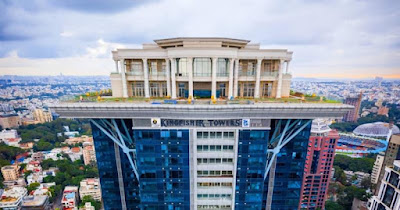Vijay Mallya: The Rise of a Business Legacy
Vijay Mallya: The Rise of a Business Legacy
When ambition, branding, and bold bets
defined India’s ‘King of Good Times’
Introduction: The Man Who Redefined
Corporate Glamour in India
Before his name became synonymous with controversy, Vijay
Mallya was celebrated as one of India’s boldest entrepreneurs—a man who
turned liquor into luxury, air travel into an experience, and business into a
brand statement. From boardrooms to racetracks, Mallya made headlines not just
for his ventures, but for how he presented them.
This is the story of how a 28-year-old inherited a
brewery and built an empire, earning admiration, envy, and eventually,
scrutiny. For budding entrepreneurs and investors, understanding his ascent
offers valuable insight into vision, branding, and calculated risk-taking.
1. Early Ascent: Taking the Reins of United
Breweries
In 1983, Vijay Mallya took over United Breweries
Group (UB Group) after the passing of his father, Vittal Mallya. At just
28, he inherited a family business known primarily for its beer brand—Kingfisher.
But Mallya had bigger plans. He wanted UB to be more than just a beverage
company.
Under his leadership, UB expanded aggressively across
sectors—engineering, chemicals, fertilizers, pharma, media, and more.
But it was the alcohol business that became his primary growth engine.
Kingfisher beer, already popular in pockets of India, was repositioned as a premium,
lifestyle-oriented brand, with slick advertising campaigns and
endorsements.
By the early 2000s, UB had become one of the largest
alcohol conglomerates in the world, and Kingfisher was selling in over 50
countries. Mallya was often referred to as the Richard Branson of India,
known as much for his flamboyance as his business acumen.
2. Kingfisher Airlines: Bold Vision Meets
the Sky
In 2005, Mallya launched Kingfisher Airlines,
promising a level of luxury that Indian skies had never seen. He famously said,
“I am not in the airline business—I am in the hospitality business. I want
people to enjoy flying again.”
The airline launched with state-of-the-art aircraft,
leather seats, in-flight entertainment, gourmet meals, and—uniquely—attractive
brand ambassadors known as the Kingfisher Girls. It was aspirational and
glamorous, mirroring Mallya’s own persona. Within a year, Kingfisher was one of
the most loved brands in Indian aviation.
Though still in its infancy, Kingfisher accounted for a
sizable chunk of the Indian market by 2008. Mallya made an ambitious move to acquire
Air Deccan, India’s first budget airline, to enter the low-cost segment.
This gave Kingfisher greater reach and flying rights—especially international
ones.
But the strategy wasn’t just about profit; it was about owning
the entire brand experience—from beer to flights to sports.
3. Big Bets: The Sports & Lifestyle
Empire
Mallya didn’t just sell products—he sold experiences.
- In
2008, he purchased the Royal Challengers Bangalore (RCB) franchise
in the newly formed Indian Premier League (IPL) for a whopping
$111.6 million.
- He
also co-owned the Force India Formula One team, bringing Indian
branding to a global sport.
- His
annual Kingfisher Calendar, filled with glamorous photography and
models, was considered the pinnacle of elite branding.
Every move Mallya made was visually loud,
media-savvy, and meticulously branded. His signature style included
tailored suits, bold sunglasses, private jets, and yachts. For a generation of
Indians, he was the poster boy of success—a dreamer who made it real.
4. The Business Legacy (Before the Fall)
Mallya's empire, at its height, was worth billions.
Kingfisher beer had a market share of over 36% in India. His airline had
a fleet of more than 60 aircraft. UB Spirits (later renamed United Spirits
Ltd.) was acquired in part by Diageo, the global liquor giant, who
valued it for its massive reach and brand loyalty.
Entrepreneurs admired his risk appetite and
visionary branding. Investors saw the empire as aspirational, though some
raised concerns over its aggressive expansion and debt-fueled growth.
"No risk, no reward" —
Mallya lived by that creed. And for a while, the rewards were enormous.
5. What Young Entrepreneurs Can Learn
Even before we examine the fall in the next blog, Vijay
Mallya’s rise offers meaningful takeaways:
- Branding
is a business asset: He turned Kingfisher into a
lifestyle symbol, not just a product.
- Bold
ideas demand execution: Launching a luxury airline in a
price-sensitive market showed conviction, if not always sustainability.
- Diversification
can amplify value: His ventures in sports and
hospitality created synergy with core brands.
- Image
matters—but only when backed by value: His iconic
image was supported by real assets, real market share, and real reach—at
least in the beginning.
Conclusion: The Peak Before the Plunge
By the late 2000s, Vijay Mallya was a household name—an
icon of Indian business with a global footprint and undeniable charisma. He
broke the mold of the traditional industrialist and showed that branding,
scale, and aspiration could redefine legacy industries.
Yet as history would show, unchecked ambition and
unsustainable expansion can flip a success story into a cautionary tale. In
the next blog, we’ll explore how that unraveling began.








Comments
Post a Comment